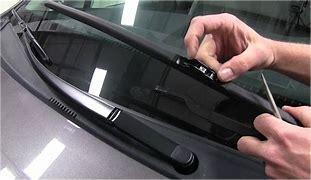Quick Wiper Blade Replacement: Save Time & Stay Safe
Discover how quick and easy it is to handle wiper blade replacement time in just 10-15 minutes. Ensure safety and visibility with our comprehensive guide on changing wipers and maintaining optimal wiper performance.
LEILI
Hower Yang
7/7/20255 min read


How long does it take to change the wiper blade
Changing wiper blades is a simple yet essential task for car owners. It ensures clear visibility during adverse weather conditions.
Many drivers wonder how long this process takes. The good news is that it’s quick and straightforward.
On average, replacing wiper blades takes about 10 to 15 minutes. This makes it a convenient DIY task for most people.
Understanding the process can save you time and money. It also helps maintain your vehicle’s safety and performance.
In this guide, we’ll explore everything you need to know about wiper blade replacement. From signs of wear to step-by-step instructions, we’ve got you covered.
Why Wiper Blade Replacement Matters
Wiper blades play a crucial role in vehicle safety. They provide clear visibility in rain, snow, and fog. If not maintained, they can impair your view, leading to dangerous situations.
Worn-out wiper blades cause streaks and squeaks on the windshield. This reduces visibility and increases driver fatigue. Regular replacement helps avoid these issues, ensuring a safe driving experience.
Poorly maintained wipers can also scratch and damage the windshield. Replacing them regularly prevents costly repairs. It’s a simple maintenance task that saves money in the long run.
Here are key benefits of timely wiper blade replacement:
Improved visibility and safety
Reduced risk of windshield damage
Prevents costly repairs and ensures clear driving conditions
Overall, investing in quality wiper blades and timely replacements is essential. It guarantees peace of mind and safety on the road for you and others.
Signs You Need to Replace Your Wiper Blades
Wiper blades don’t last forever. Knowing when to replace them is important. Certain signs indicate it's time for new blades.
Streaking on the windshield is a common indicator. This happens when the rubber has worn down. It prevents the blade from clearing rain effectively.
Squeaking or chattering noises are another sign. These sounds occur when blades lose their flexibility. Reduced contact with the windshield causes them to skip.
Sometimes, physical damage is visible. Cracks or tears in the rubber are clear signs. In such cases, immediate replacement is necessary.
Here's a quick list of signs:
Streaking or smearing of water
Loud squeaking sounds
Skipping across the windshield
Visible cracks or tears
Addressing these signs promptly helps maintain optimal driving conditions. It ensures the wipers perform well during adverse weather, enhancing safety for everyone on the road.
How Often Should You Change Wipers?
Wiper blade lifespan varies based on several factors. Generally, replacing them every 6 to 12 months is recommended. This timeframe helps ensure optimal performance and safety.
Environmental conditions affect how often you need new blades. In areas with frequent rain or snow, more frequent changes may be necessary. Harsh sun and high temperatures can also cause faster deterioration.
Consider using a checklist to determine when to change wipers:
Examine blades every few months for signs of wear
Replace immediately if performance decreases
Follow the vehicle manual for specific guidance
Regular checks and replacements are essential. They prevent unexpected issues and ensure that your wipers are always ready when needed.
What Affects Wiper Blade Replacement Time?
Several factors can influence how long it takes to replace wiper blades. Understanding these can help you plan effectively for the task.
Vehicle design plays a significant role. Some cars have easy-access wiper arms, while others may require additional steps. Different attachment systems, such as J-hook or pin configurations, also affect timing.
Your experience level is another important factor. Those familiar with the process may complete it faster. Beginners might need more time to ensure everything is done correctly.
Consider these elements that can impact replacement time:
Complexity of the vehicle's wiper system
Availability of proper tools and parts
Your familiarity with the vehicle model
Taking these aspects into account can lead to a smoother and quicker wiper blade replacement experience.
Step-by-Step Guide: How to Change Wiper Blades
Changing wiper blades is a straightforward task. With the right tools and technique, it becomes even easier.
Before starting, make sure your car is turned off. Place the wiper arms in a service position for easier access. Most vehicles have a simple release mechanism for the wiper blades.
Here's a clear guide to help you through:
Locate the release tab on the wiper blade.
Press the tab to loosen the blade.
Slide the old wiper blade off the arm.
Once the old blades are removed, it's time to install the new ones. Ensure the new blades are the right size for your vehicle model.
After removing the old blades, follow these steps to install the new ones:
Slide the new blade onto the arm.
Listen for a click to ensure it's secured.
Check the attachment to confirm it’s secure.
Properly replacing the blades ensures they function well. Incorrect installation might lead to inefficiencies during use. It’s essential to double-check the installation for safety.
Remove the Old Wiper Blades
To begin, focus on safely removing the old blades. Engage the release mechanism to detach them.
Follow these steps to remove the old blades effectively:
Lift the wiper arm away from the windshield.
Find and press the release tab.
Gently slide the blade off the wiper arm.
Handling the wiper arms with care is crucial. This prevents accidental damage to the windshield. Protect yourself and your car by taking your time.
Install the New Wiper Blades
With the old blades removed, installing new ones becomes the focus. Align the new blades with the wiper arms properly.
Here's how to attach the new wiper blades:
Position the new blade at the arm's base.
Slide it gently until it clicks into place.
Confirm the blade is securely attached.
A firm attachment ensures proper functionality. Avoiding a loose connection prevents operational issues. Once installed, double-check to ensure reliability.
Test and Inspect the New Wipers
Testing your new wipers is a simple but essential step. Start your car and activate the wipers.
Ensure they move smoothly across the windshield. Confirm there are no skipping or squeaking noises. A visual inspection also helps verify everything is in place. Such diligence ensures safety during adverse weather conditions.
Tips for a Smooth Wiper Blade Replacement
Replacing wiper blades can be straightforward with a few handy tips. First, always ensure you have the correct size and type of blades. This prevents fitting issues and ensures efficient performance.
Secondly, gather all necessary tools before starting. This helps avoid interruptions and ensures the process is swift.
Here are additional tips for a successful replacement:
Read your vehicle manual for specific instructions.
Use a soft cloth to protect the windshield while working.
Check online tutorials for visual guidance if needed.
Finally, always handle the wiper arms with care. This avoids damage and ensures a secure fit. By following these tips, you ensure a quick and efficient wiper blade replacement.
Common Mistakes to Avoid When Replacing Wipers
Replacing wipers seems simple, but common mistakes can complicate the process. First, using the wrong size blades can lead to inefficient wiping and potential damage.
Another mistake is not checking the wiper arm or linkage beforehand. A broken arm can cause incomplete wiping or damage to the new blades.
Avoid these errors by:
Double-checking blade size for your vehicle.
Inspecting the arm and linkage for wear or damage.
Securing new blades firmly to the arms.
Always follow instructions carefully to ensure a flawless replacement process.
When to Consider Professional Help
Sometimes, replacing wiper blades can pose unexpected challenges. If you encounter stubborn wiper arms or complex blade types, professional assistance is advisable.
In cases where issues extend beyond the blades, such as faulty wiper linkage or motor problems, it's best to seek expert help. A professional ensures everything functions correctly and safely.
Frequently Asked Questions About Wiper Blade Replacement Time
One common question is how long it typically takes to change wiper blades. Generally, it takes about 10 to 15 minutes, but it can vary.
Another frequent inquiry concerns the correct size and type of wiper blades. It is crucial to refer to the vehicle manual or consult an expert.
For further clarity, here's a quick FAQ list:
How often should wiper blades be replaced? Every 6 to 12 months.
Can worn wipers damage the windshield? Yes, old wipers can cause scrathes.
Are professional services faster than DIY? Often, but DIY is cost-effective.
Conclusion: Keep Your Wipers in Top Shape
Regular wiper blade maintenance is vital for safety. Properly functioning wipers ensure clear visibility during adverse weather.
By following simple replacement steps, you can manage this task with ease. Don't hesitate to replace blades when necessary. Consistent care and timely replacements will keep your windshield clear, contributing to a safer driving experiance.
